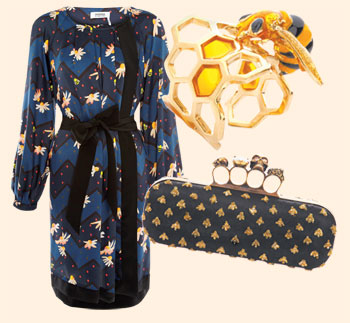Hive mentality
Simply sign up to the Life & Arts myFT Digest -- delivered directly to your inbox.
They came in swarms to Westminster, some clad in traditional beekeeping suits and veils, others dressed as striped militant worker bees. Dame Vivienne Westwood and Katharine Hamnett were also there, milling among the crowds in combat queen bee mode.

Such was the scene, anyway, in April at the March of the Beekeepers: a protest in Parliament Square calling on the UK government to vote in favour of a European Union ban on neonicotinoid insecticides, blamed by ecologists and scientists for the rapid decline of bee colonies across Europe and North America. But the movement is far from over. Indeed, something similar is being re-enacted at boutiques throughout the summer as ready-to-wear designers also put the bumblebee on the global agenda.
Consider Azzedine Alaïa’s honeycomb pleating on skirts and dresses; Alexander McQueen’s resin bustiers and cuffs crawling with imitation bees; Marios Schwab’s hexagonal patterns; and Sonia Rykiel’s printed bumblebee motifs.
“At the moment, bees are very much in the ‘design psyche’,” says Yelena Ford, lead strategist for the international brand consultants Wolff Olins, which put beehives on the roof of its London offices four years ago. “There seems to be something mutually reaffirming as honeycombs and bees are used as inspiration across a wide variety of disciplines.”
Sarah Burton, creative director at Alexander McQueen, says: “We wanted to express lightness, for the clothes to almost hover [like bees] over the women who wear them.” She has put apian references on just about everything – from pencil skirts and sharply-executed jackets cut from honeycomb jacquards and mesh; Plexiglas belts (£650), neckpieces (£860), and cuffs (£460) embellished with topaz crystal bees; to the beekeeping headdresses the models (all 32 of them) wore during the runway show last September. “The collection is a study of femininity. It’s about sensuality and skin but not nudity.”
Jeweller Delfina Delettrez’s current collection includes rings featuring bees crawling on honeycomb (£269, pictured below right) and gold-plated bracelets (£225) made with chains of glossy enamelled bees. Delettrez, part of the Fendi dynasty, says: “I relate to bees, they are very matriarchal just like my family.”
“The bracelets are meant to look as if they have been rolled around the wrist, almost as if the hand has been ripped from the inside of a hive and honey is dripping off it,” she adds, admitting when she is not creating fine jewellery, she is often engrossed watching documentaries on honeybees and other insects.
In an attempt to make each piece as natural-looking as possible, Delettrez omits safety fastenings and locks. She also uses orange resins and gold-coloured enamel to represent globules of sticky nectar.
London-based designer Marios Schwab prefers to spread honeycomb graphics around the body by way of lace-work dresses and cashmere knits. “I like the geometric structure of the honeycomb – the way it connects and reconnects,” says Schwab. “I wanted to make continuous patterns with it, starting with small scale and increasing to even bigger shapes. It ended up being quite tricky and mathematical but, ultimately, an enjoyable process.”

The plight of the honeybee is something Schwab also holds close to his heart. On the Greek island of Astypalea where he grew up, his family still tend their own beehives. “They are extremely resourceful little creatures and I think fashion has made a conscious decision to help them,” says Schwab.
But will this bee-moment pass like other trends, or is it indicative of some greater connection?
“I think this will have longevity because pure shapes, such as hexagons, offer endless possibilities,” says Ford from Wolff Olins. Indeed, Wolff Olins has started its own Honey Club with the aim of building the biggest bee-friendly network in the world, and its creative staff often look to the bees at work as a source of design inspiration.
Carmen Busquets, founder of luxury shopping site CoutureLab.com, agrees. “The honeycomb pattern will always be beyond trends,” she says. “It was been used in the 1950s by Cristóbal Balenciaga and in the 1980s by Sybilla and, of course, now by Alaïa, who has mastered this texture in all kinds of shapes to dramatic effect.”
“Bees are the femmes fatales of the eco system,” says Marios Schwab.
——————————————-
Comments